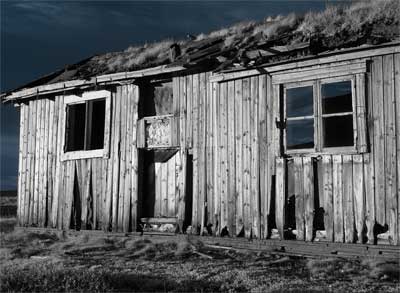Equipment for shift lens stitching *
I’ve had a few queries about what equipment to use for creating a “stitched” image using shift lenses. While time doesn’t allow a full article just now, I thought I’d show what my current setup is for making stitched images. Look for the authoritative guide on making stitched images using a shift lens around the mid-2007 time frame.
Se also 28mm Shift Lenses in DAP as well as Gigapan Epic Pro.
Shown below is a reduced-size version of a 26-megapixel infrared image (5967 X 4368 pixels). It was created by taking three frames on the Canon 5D-IR with the Nikon 85mm f/2.8D PC-Micro Nikkor: a center frame, a left frame shifted by 12.4mm, and a right frame shifted by 12.4mm. (12.4mm is the maximum shift the 85mm PC-Micro Nikkor allows). That’s a “virtual” sensor width of 12.4 + 12.4 +24 = 48.8mm, or 2.03X that of a single frame (in landscape mode it would be 1.68X that of a single frame).
The result is easily sharp enough for a 48-inch wide print, as the combination of the Canon EOS 5D-IR and the Nikon 85mm PC-Micro-Nikkor is magical , provided that perfect focus is achieved.
Parallax is the displacement of an object due to a change in the position of the observer. In this case, the “observer” is the lens, which moves left or right (or up or down) when shifted, thus altering the angle from which the subject is seen. This differs from a view camera, which offers the choice of shifting either the rear (sensor/film) or the front (lens). In my about page, I can be seen posing with a view camera. With high-resolution cameras such as the Canon EOS 5D, an 85mm lens poses parallax problems even 300 feet or more away—just try getting power lines to align. The human eye (brain) is amazingly good at detecting discontinuities, so if you want to do precise work, parallax must be dealt with.
To defeat parallax, a countershift must be done. Failing to do so would be a very serious problem with this image due to the many straight lines which must join precisely, a nightmare of post-processing hand-work in Photoshop.
My equipment allows a precise countershift, or movement of the camera/lens assembly by precisely the same distance as the shift, but in the opposite direction. If the lens is shifted 12.4mm to the left, the entire camera/lens assembly should be shifted 12.4mm to the right, thus putting the front of the lens in precisely the same position as prior to the shift. This technique yields parallax-free frames which can then be trivially combined. Equipment that makes it easy and reliable is best, which brings us to today’s topic (click for larger version):
The assembly consists of three Really Right Stuff parts**:
- A PCL-1 panning clamp (A) (mine
is an older version; the newer ones are even better). The PCL-1 is handy for rotational stitching (3) [an
entirely different approach], but for shift-lens stitching any ordinary clamp would do just as well, so long as it
has reference marks. The PCL-1 has a few laser-engraved reference marks, but it would be much better if it were engraved
at 1-millimeter intervals.
- A “CRD-Rail” (B),
clamped into (A). The CRD-Rail rail is laser-engraved, which makes it easy to execute
a precise countershift using the reference mark on the clamp (1). The CRD-Rail also sports
a clamp at one end (2), thus enabling vertical countershifts, something I long
went without, with no small frustration.
However, you’ll have to scratch reference marks into the clamp because it bears no markings, not even a center mark (this is not really right, and I’ve passed along this suggestion to RRS before, apparently to no avail). You’ll also notice that when employed in this capacity, the CRD-Rail has its numbers upside-down. Since an “L” bracket on the camera is at camera-left, the CRD-Rail must be used as shown above, which looks odd, but works just fine. - A B2-FAB (C) back-to-back clamp. Again these clamps could use laser-engraved reference marks.In this particular case, the countershift is executed by sliding the CRD-Rail in the PCL-1 clamp, or the camera in the CRD-Rail clamp, so no reference marks are needed on the B2-FAB.
To summarize the countershift technique—
- Take a center frame.
- Shift the lens to the left, loosen the clamp, countershift the assembly to the right, tighten the clamp, then take a 2nd frame.
- Repeat step 2, but in the opposite direction.
The result is 3 parallax-free frames which can be seamlessly merged, though some blending might still be needed due to minor density differences, or slight subject movement.
Of course, all of this must be done with care, so be sure of a solid tripod setup, and make sure that everything else is locked down; don’t bump the tripod between frames, etc. Focus and exposure must be set manually so as to be identical for all 3 frames. Doing all this right means very little post-processing effort; doing it almost right means a huge hassle merging the frames if any of the subject matter is close (relative to the focal length).
The whole setup can be simplified by eliminating (B) and (C), and shifting the camera with attached L-bracket within (A). However, the lack of laser-engraved marks on the L-bracket, and the limited reference marks on the PCL-1 make this a trickier business to execute reliably, and vertical countershifts are not possible. Please, RRS, get the laser engraving really right on the PCL-1 panning clamp and the other clamps!
* not be be confused with “shit lens stitching”, a not-uncommon problem.
** Most of their “stuff” is really right, but some of it could be improved




























